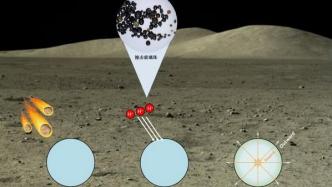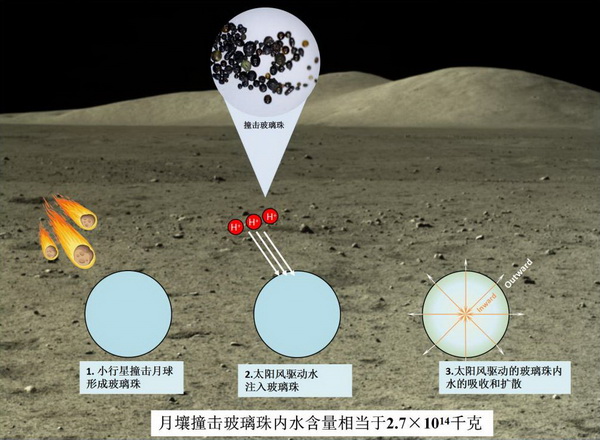
Over the past 20 years, scientists have found evidence of water on the lunar surface. Some scientists speculate that there is an aquifer deep in the lunar soil, which drives the water cycle of the entire moon. So, where does the water on the moon come from? Where is it stored?
Now, Hu Sen, a researcher at the Institute of Geology and Geophysics of the Chinese Academy of Sciences (hereinafter referred to as the Institute of Geology and Earth), and Hui Hejiu, a professor at the School of Earth Science and Engineering at Nanjing University, and other scientists have discovered that the impact glass beads may be the "mini reservoir" of the moon—— One ton of glass beads can contain an average of one catty of water. Relevant research results were recently published in Nature-Earth Science.
"Our research proves that the impact glass beads may be a new lunar water storage material, supporting the conjecture of the lunar surface water cycle, and also explaining the potential source of water on asteroids without atmospheres like the moon." Hu Sen, the corresponding author of the paper, said "Chinese Journal of Science" said.
With the advancement of lunar exploration, researchers believe that the prospect of extracting water through a large number of glass beads can be expected.
an unexpected discovery
One day in the winter of 2021, when He Huicun, a doctoral student at the Key Laboratory of Earth and Planetary Physics of the Institute of Geology and Earth Sciences, used a nano-ion probe to detect the impact glass beads in the Chang'e-5 lunar soil samples, he found that the water abundance in the beads ranged from outside to Gradually decreasing inside, forming a "ring belt feature".
She submitted this result to her mentor, Hu Sen. Hu Sen's first reaction was "I can't believe it".
Soon, Hu Sen told Hui Hejiu the news. Although the two are familiar with lunar samples, the partner's reaction was the same as his: "Could it be that the experiment was wrong?"
From the moon to Mars and even other planets more distant, looking for clues related to "water" has always been a starting point for scientists to study the history of planets and the habitability of life.
At present, studies have shown that although there is water on the lunar surface, the content is low and changes dynamically. For example, the water content on the lunar surface is only 10-1000ppm (that is, one ton of lunar soil contains 0.01kg-1kg of water). At the same time, the water content in high-latitude regions is obviously higher than that in low-latitude regions, and water ice may exist in polar regions. The water content of the lunar surface shows a change related to the day and night of the moon, and the water content at the same position at dawn and dusk is significantly higher than that at noon.
Although the moon has almost no atmosphere, there is also a water cycle on the surface of the moon.
NASA's Lunar Atmosphere and Dust Environment Exploration Mission has detected that the escape time of water molecules in the lunar space environment is related to meteor shower events. However, according to calculations, the amount of water input into the meteor shower is significantly less than the amount of water escaping from the lunar space. NASA scientists speculate that when the meteor shower hits the moon, some of the water stored in the lunar soil will evaporate into the lunar space and cause escape, and a conjecture of the lunar surface water cycle is proposed. This conjecture believes that there may be undiscovered water reservoirs in the 10 cm to 3 m region of the lunar surface.
However, in recent years, many people at home and abroad, including Hu Sen, have done research on different minerals or components of the moon that do not support this hypothesis. "The water content in these minerals is extremely small." Hu Sen told the "China Science Daily" that he and his collaborators previously found that the whole rock water content in the Chang'e-5 lunar basalt was only 62-133ppm.
So, is the lunar surface water cycle conjecture true? Are there undiscovered water storage substances in the lunar soil?
Husson and collaborators tried to answer this question with impacting glass beads. Impact glass beads are formed when meteorites and asteroids in space hit the moon and melt the soil and rocks on the lunar surface, and the melt is sputtered to form liquid droplets and cool down. Some of them have a single internal composition, and some contain different components such as bubbles, metals, and sulfides. The lunar soil returned by the Chang'e-5 and Apollo missions contains different components such as rocks, mineral fragments, volcanic glass beads, and impact glass beads. The abundance of water in impacting glass beads has not been studied in detail before.
The initial results completely exceeded their expectations—the "ring signature" of the abundance of water inside the glass beads suggested that it was likely coming from the solar wind.
In order to verify this result, they repeated experiments over and over again, and selected 32 glass beads with smooth surface and consistent chemical composition with lunar basalt from more than 110 lunar soil glass beads. Through scanning electron microscope, ion probe and Raman spectrum After testing in various ways, it was found that the results were consistent with the original ones.
They found that the water abundance of glass beads is higher than that of lunar soil debris, with a maximum of nearly 2000ppm. "This corresponds to about two kilograms of water in one ton of sample," Husson explained.
"Get through" the lunar water cycle chain
Scientists have many conjectures about the source of lunar surface water. For example, hydrogen ions carried by the solar wind were injected into the minerals on the lunar surface, water was present in the early formation of the moon and remains today, and carried by comets and asteroids when they hit the moon.
In fact, whether it is magmatic activity or an impacting celestial body (carrying water source), it is possible to form impacting glass beads through high-temperature melting. How do researchers determine that the "water" in the impacting glass beads comes from the solar wind by virtue of the "ring characteristics"?
In this regard, Hui Hejiu explained to the "Chinese Journal of Science": "Usually, when glass beads are formed by high-temperature melting, 'water will run out', so the water abundance in the glass beads is more likely to be 'high on the inside and low on the outside'. Condition."
At the same time, as the lightest hydrogen in the periodic table, scientists can identify its source by identifying its isotopic (protium, deuterium, tritium) characteristics. By detecting the hydrogen isotope in the glass beads, the researchers found that it was consistent with the hydrogen isotope composition of the solar wind and was extremely depleted in deuterium.
These phenomena led them to speculate that the impact of glass beads may verify the conjecture of the lunar surface water cycle: in the past billions of years, after meteorites or asteroids impacted to form glass beads on the lunar surface, hydrogen ions in the solar wind continued to reach the moon and inject into the surface. In the glass beads of the moon, it forms the source of lunar water and maintains the water cycle on the lunar surface.
"The impact glass beads are mainly composed of silicates, like a sponge. Hydrogen injected into them may combine with oxygen to form water, or it may be released under other conditions." Hussen explained that they also found that some glass beads were in the Later, they even experienced a certain degree of impact or heating events, resulting in a degassing process superimposed on the water content profile.
For billions of years, the "plowing effect" brought about by the impact of space objects has made impact glass beads (about 3~5vol%) common in lunar soil. The researchers estimate that the amount of water carried by the impact glass beads in the lunar soil can reach 2.7×1014 kg. "This is far lower than the water storage of the four oceans of the earth (about 1×1021 kilograms), but it is relatively considerable." Hussen said.
Based on these results, they believe that these impact glass beads, which are about the thickness of a hair (about 30–150 micrometers), are the main water reservoirs in the soil on the lunar surface, excluding the ice at the lunar poles.

Photo courtesy of Hu Sen et al.
The prospect of glass beads for water extraction is promising
In the next step, if astronauts are stationed on the moon, can they directly "take water on the spot"?
Hui Hejiu said that the extraction of water through a large number of glass beads has a prospect, but this kind of water is different from the water usually seen on the earth. The water in the glass beads mainly exists in the form of hydroxyl (-OH), and how to develop and utilize it still needs further research. .
The reviewers found the study to be very interesting and to present important new findings. "Inward diffusion of volatile elements was reported in a 1972 study, but the discovery of impacting water in glass beads has not been reported. The authors have provided strong evidence for the presence of hydroxyl groups through a comprehensive set of analyses." A reviewer The author wrote.
In addition, with the improvement of detection capabilities, scientists have discovered that there may be water on the surface of more and more non-atmospheric celestial bodies, such as Vesta and Mercury. According to the researchers, this study has important implications for understanding the origin and origin of water in the low latitudes of these planets.
"Subsequent more in-depth and detailed research, such as the source, preservation, and migration mechanism of water on the surface of non-atmospheric celestial bodies, will have important reference value for the design of in-situ water resource utilization and extraction strategies for future deep space exploration missions." Hu Sen explain.
Related paper information:
https://doi.org/10.1038/s41561-023-01159-6
(Originally titled "Scientists Discover Moon "Mini Reservoir")